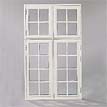Environment
Oil Point example: "Window frames"
This example deals with the evaluation and comparison of
two window frames: one in wood and the other in PVC with steel core.
The comparison is done in three steps:
1. Focus, 2. Evaluate and 3. Interpret.
Step
1:
FocusThe Functional Unit is defined as follows:
"Provision of a frame of 118 cm x 118 cm for a two-layer insulation glass
pane in mechanically and optically good condition for 40 years in Denmark".
It is assumed that the PVC-window is recycled in the disposal phase.
Step 2
Evaluate
(PVC-frame)|
Material, PVC/steel frame |
[OP/kg] |
[OP/product] |
|
PVC-plastic granulate, 6 kg |
1.5 |
9 |
| electroplated steel profile, 6 kg | 0.7 | 4.2 |
|
Materials, sub total: (12 kg) |
13.2 |
|
|
Manufacturing |
[OP/kWh] |
[OP/product] |
| electricity, 3.7 kWh |
0.25 |
0.9 |
|
Manufacturing, sub total: |
0.9 |
|
|
All Transport |
[OP/t-km] |
[OP/product] |
|
Truck (before and after use), 20 t-km |
0.01 |
0.2 |
|
All Transport, sub total: |
0.2 |
|
|
Use |
[OP/product] |
|
|
- |
0 |
|
|
End-of-Life |
[OP/kg] |
[OP/product] |
|
land filling of PVC/steel |
0 |
0 |
|
TOTAL PVC/steel frame: |
14.3 OP |
Step 2
Evaluate
(wooden frame)|
Material, Wooden frame |
[OP/unit] |
[OP/product] |
|
Wood, 9 kg |
0.1 |
0.9 |
| electricity (for drying), 2.3 kWh | 0.25 | 0.6 |
|
Materials, sub total: |
1.5 |
|
|
Manufacturing |
[OP/kWh] |
[OP/product] |
| electricity, 12 kWh |
0.25 |
3 |
|
Manufacturing, sub total: |
3 |
|
|
All Transport |
[OP/t-km] |
[OP/product] |
|
Truck (before and after use), 1.1 t-km |
0.01 |
0.011 |
|
All Transport, sub total: |
0.011 |
|
|
Use |
[OP/product] |
|
|
- |
0 |
|
|
End-of-Life |
[OP/kg] |
[OP/product] |
|
land filling of wood |
0 |
0 |
|
TOTAL Wooden frame (rounded): |
4.5 OP |
Step 3:
Interpret With an impact of about a third, OPM indicate that the wooden frame performs better than the PVC/steel version. In both cases, almost the entire impact results from materials respectively manufacturing stage - transport, use and end-of-life are negligible here.
Seen in a holistic context, the decision upon the materials for the frames
becomes obsolete - considering the heat loss through the window pane.
Estimating a loss of 15 kg heating oil per year over the 40 years life
time, an impact of 600 OP occurs due to the heat loss. This is about 42
times the impact of the worse version
Improvement potentials lie primarily in the system "window"
as such, especially in the insulating property of the window pane. If
focusing on the frame material anyway, the material with the lower thermal
conductivity should be chosen.
ReferencesNiki Bey: The Oil Point Method, 2000
Image CopyrightThis page is part of Design inSite
Disclaimer: The Oilpoint information can not be used for legal purposes! Design inSite has no responsibility for the correctness of the data.
